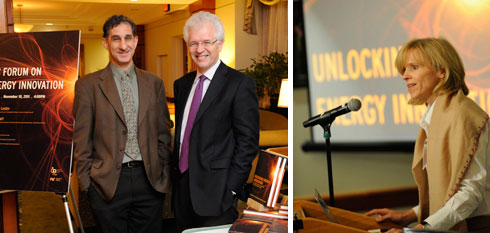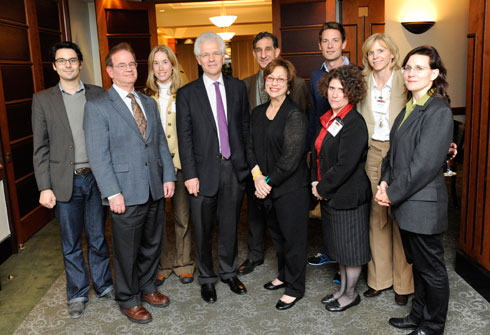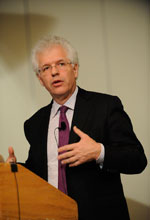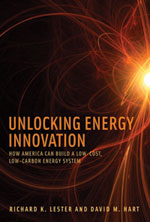IPC Forum on Energy Innovation:
New Ways Of Developing Clean, Reliable, Affordable US Energy Supplies
Energy is the lifeblood of the industrialized world, providing light, heat, transport, and thousands of vital benefits. But energy dependence also creates a complex collection of challenges, including carbon emissions that are tightly linked to climate change, oil spills, nuclear accidents, economic pressures, and regional and global political tensions.
The result: an unsustainable situation, with deeply intertwined environmental, economic and political consequences for the US and the world.
On Nov. 10, MIT’s Industrial Performance Center hosted a Forum on Energy Innovation, discussing the results of an interdisciplinary three-year project aimed at creating strategies for clean, affordable, reliable energy supplies in the 21st Century.
The IPC’s Energy Innovation Project engaged scientists, engineers and social scientists from across and outside the Institute, and has produced a new book, Unlocking Energy Innovation, that reviews the entire US energy production and consumption chain, and offers new proposals for spurring ongoing, systemic innovation to boost efficiency and make low-carbon energy technologies effective and economical.

Co-authors David M. Hart & Richard K. Lester; Elisabeth Reynolds, IPC Executive Director
‘The Energy Innovation Project, and our book, paint a clear picture,” stated co-author Richard Lester, IPC co-chair and head of MIT’s Nuclear Science and Engineering Department. “We face a very big innovation challenge over the next few decades – bigger, perhaps, than most people realize. While parts of the U.S. energy innovation system are working well, the system as a whole is not up to the task of delivering hundreds of billions of dollars of mostly private investment into cost-competitive, scalable, and environmentally benign new technologies; making thousands of new sites available for often-controversial energy facilities and infrastructure; and training tens of thousands of young people annually, from craft workers to Ph.D. scientists."
Lester added, however, that these challenges can be met, if full measures of creativity and rigor are applied to the redesign of the “institutions of innovation” - the complex web of indirect incentives, direct government support, regulations, research and educational institutions, codes, and standards that affect energy production and consumption. All of these interact to affect the markets where new technologies are developed and taken up by energy suppliers and users.
“This is difficult and messy territory,” explained Lester. “It gets into very micro details, but it’s also essential to stay focused on the big picture. The fact is that no single innovation will solve all our problems. We need a sustained flow of innovations of different kinds over several decades.”
To this end, forum panelist Peter Rothstein, president of the New England Clean Energy Council, praised the book’s conceptualization of energy innovation as a system rather than a pipeline, as the system model takes into account feedback loops, markets, and interrelationships between different players – a much more realistic and valuable conception.

Left, l to r: Richard K. Lester, Daniel Goldman, David M. Hart, Peter Rothstein, Neil Rasmussen. Right, l to r: David M. Hart, Neil Rasmussen, Daniel Goldman, Peter Rothstein, Richard K. Lester
Co-author David Hart, a George Mason University professor of public policy currently serving as assistant director for innovation policy in the US Office of Science and Technology Policy (but speaking only in his non-official role as a professor), described three waves of innovation outlined in the book.
The first focuses on energy efficiency, particularly in buildings, which consume 40 percent of energy and 70 percent of electricity. Emphasizing that this involves well-known techniques and practices, and can likely be implemented through upgraded building codes, Hart quoted Lawrence Berkeley National Lab scientist Steve Selkowitz’s comment that, “this isn’t low-hanging fruit; it’s fruit that’s lying on the ground rotting.”
The second wave, which overlaps the first but will take longer to have an impact, focuses on large-scale deployment of low-carbon electricity generation, transmission, distribution and use, including nuclear, solar and wind power, carbon capture, electric/hybrid transportation, and energy storage. Hart noted that this gives rise to perhaps the most novel proposal of the project — a surcharge on electricity usage, which would go to state-level trustees, who would be required to invest in public-private Regional Innovation Investment Boards. These RIIBs would compete with one another for funds, and would in turn be responsible for funding demonstration projects and early-deployment programs that accelerate economical low-carbon electricity technologies.
Panelist Rothstein also supported this concept, noting that the RIIBs would not be federal or purely public entities, would draw capital from within the energy system, and would seek opportunities with particular economic value and proximity to their regions.
While Lester and Hart assert that these two initial waves can drive an 80 percent reduction in US carbon emissions by 2050, in line with a recent Presidential proposal, they note that further reductions will be needed and may require breakthrough options. These could include carbon-neutral biofuels, advanced solar technologies, nuclear fusion and novel conservation techniques. The study calls for more funding for fundamental research, better international collaboration, and tighter ties between federally funded advanced research groups and the rest of the energy innovation system.
Opening the forum’s panel discussion, Neil Rasmussen (’76, SM ’80), senior VP of innovation for Schneider Electric, said he had witnessed the difficulty of selling electrical products based on efficiency, typically a low customer priority. As a result, he said, he believes that “there’s a lot to be said for regulation-driven innovation and standard — we used to fight for years over our strategy for more-efficient products, but when something like Energy Star comes out, it’s a five-minute discussion. You stop making products that don't meet the standards and start making ones that do.”
The third panelist, Daniel Goldman, executive VP and CFO of GreatPoint Energy, noted that while substantial amounts of venture capital are flowing into alternative energy, there is a gap when capital-intensive programs, such as gasification with CO2 capture, reach the scale-up stage and requires large-scale plants costing $1 billion or more. “There is really no market for providing the capital to scale up these technologies,” he said. “We need to figure out funding structures to get innovations out of the labs. And if we don’t do it, others will — China is doing it in spades.”
The IPC’s future agenda includes work on specific aspects of the US energy innovation system as outlined in the book, such as regional innovation systems and early adoption strategies, noted executive director Elisabeth Beck Reynolds.

IPC research team & staff: Florian Metzler (graduate student), Dr. Harvey Michaels (DUSP), Ashley Finan (graduate student), Prof. Richard K. Lester, Prof. David M. Hart, Anita Kafka, Jonas Nahm (graduate student), Carol Sardo, Dr. Elizabeth Reynolds, Kathy Araujo (graduate student).
Videos

Richard Lester discussed his new book, co-authored with Prof. David Hart of George Mason University, entitled, Unlocking Energy Innovation: How America Can Build a Low-Cost, Low-Carbon Energy System at MIT on 14 November 2011. The event was co-sponsored by the MIT Energy Club.
- Richard K. Lester
- David M. Hart
- Elisabeth Reynolds
- Peter Rothstein
- About the book
- MIT Energy Club
- IPC
Written by Peter Dunn
Photos by Richard Howard

